Wow, was my timing ever bad. There I was, ready to leap into the Last Minute Elf week just as I was finishing the new workbench. And, all through last week, I was dying to show you how it worked, but my patience was rewarded.
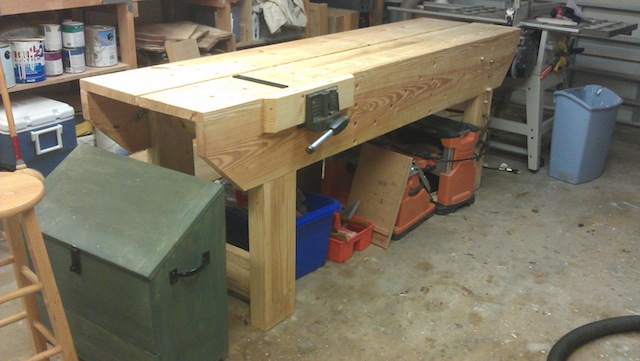 Yes, this is a Nicholson bench, styled after the one drawn up by Peter Nicholson in his 1831 book Mechanic’s Companion. It’s a traditional English carpenter design, and it has some pretty cool features that my old bench never could have dreamed up.
Yes, this is a Nicholson bench, styled after the one drawn up by Peter Nicholson in his 1831 book Mechanic’s Companion. It’s a traditional English carpenter design, and it has some pretty cool features that my old bench never could have dreamed up.
Yes, this was all built with dimensional 2 x lumber, all southern yellow pine. It did take some time in the local home center, picking out the flattest boards that didn’t contain the pith (center) of the log. I have cut a few boards with the pith in them, and they seem to warp and pinch on blades, making sawing them a pain in the patootie. I also had to make sure they were as flat as possible. Surprisingly, you can pick up a warped board very easily.
As you have seen in the previous posts, the construction is very straightforward. Mostly screws and glue, the bench went together easily, and I took my old Wilton vise off the old bench and put in on the face of the new one where it went to work immediately.
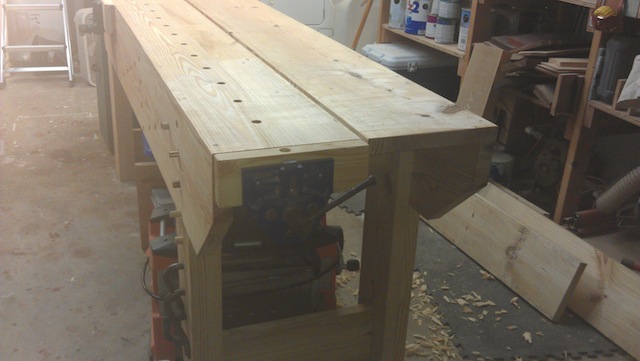 I also took an old Record quick-release vise off the front bench in my shop and bolted it to the tail end of the bench. I also attached a chop to this vise, and it’s ready to work as a tail vise for planing on those long boards. I also lined up the dog holes so I could use those in concert with the dog hole on the vise.
I also took an old Record quick-release vise off the front bench in my shop and bolted it to the tail end of the bench. I also attached a chop to this vise, and it’s ready to work as a tail vise for planing on those long boards. I also lined up the dog holes so I could use those in concert with the dog hole on the vise.
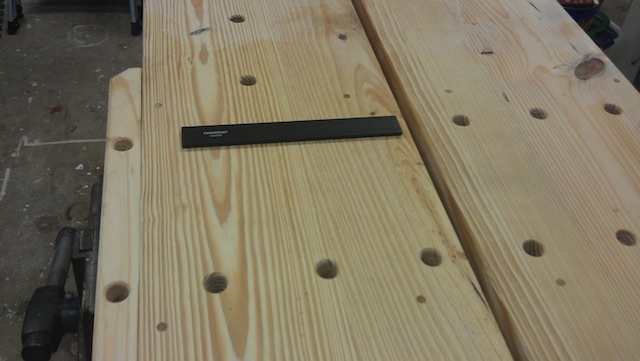 Down closer to the face vise, I threw my recently purchased Veritas planing stop. It is one handy little tool, securing into a pair of dog holes so I can plane against it. As you can also see, I built the top as a split top, meaning I can insert a 1/2 inch board into the crack to serve as an additional stop to plane across boards.
Down closer to the face vise, I threw my recently purchased Veritas planing stop. It is one handy little tool, securing into a pair of dog holes so I can plane against it. As you can also see, I built the top as a split top, meaning I can insert a 1/2 inch board into the crack to serve as an additional stop to plane across boards.
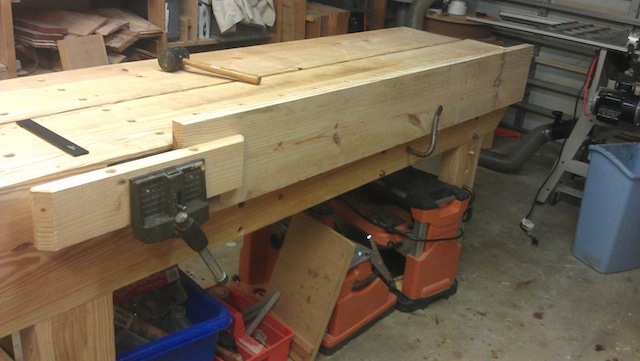 The real magic about this bench is the choice of clamping arrangements. The front aprons are drilled with a pattern of holes where I can use a series of bench dogs and holdfasts to secure long and heavy boards to the bench so I can work on them. As you can see above, a leftover 2 x 10 is clamped into the vise chop, balanced on a pair of bench dogs in holes and held in place tightly against the bench with a holdfast. Believe me, that board is NOT going anywhere.
The real magic about this bench is the choice of clamping arrangements. The front aprons are drilled with a pattern of holes where I can use a series of bench dogs and holdfasts to secure long and heavy boards to the bench so I can work on them. As you can see above, a leftover 2 x 10 is clamped into the vise chop, balanced on a pair of bench dogs in holes and held in place tightly against the bench with a holdfast. Believe me, that board is NOT going anywhere.
The best part about this bench? It cost me a grand total of $70 in lumber (I already had the vises, glue and screws around the shop) and took – brace yourself – about 15 hours for me to turn the stock into the bench.
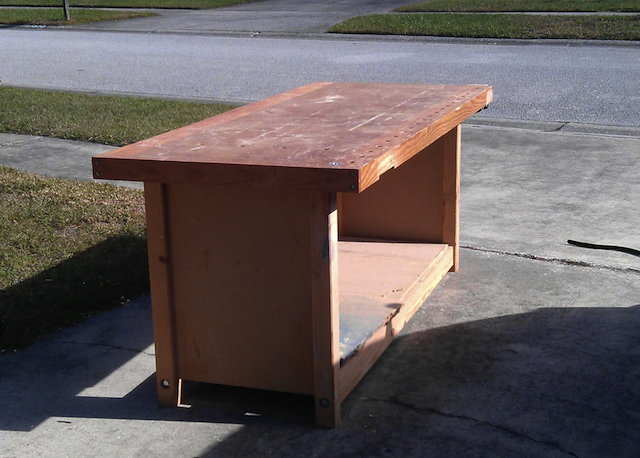 And, what happened to the old bench, you may be asking? Well, my neighbor saw me working on the new one and asked me what I was going to do with the old one. I told him that it was his (if he wanted it), and later that morning, we carted it down the street to his house, to become the heart of his workshop. I hear I may have visitation rights…
And, what happened to the old bench, you may be asking? Well, my neighbor saw me working on the new one and asked me what I was going to do with the old one. I told him that it was his (if he wanted it), and later that morning, we carted it down the street to his house, to become the heart of his workshop. I hear I may have visitation rights…

Nice work Tom. I would agree on the aprons being useful, I had my reservations but they worked out fine. I like the overall feel of this piece, it feels like a proper old joiners bench, no bs, just ready for work.
Great looking bench, Tom. You really have me considering the Nicholson as my next bench, since it’s so budget friendly, but would be a huge upgrade over my machinist type that has little clamping area. One question I had is: how is your experience with holdfasts on the top? I have heard that some folks have concerns using them on less than a 2″ top, but wanted to hear your take. Thanks!
Jim –
When I built the bench, I blocked in between the cross stretchers with pieces of 2 x 10 glued and screwed in from underneath. This makes the dog holes 3″ thick at those points, which makes putting in holdfasts a piece of cake. That also added more mass to the bench, making it heavier and less likely to ‘wander’ when I plane on it.
But, even on the sides where the wood is only 1.5″ deep, the hold fasts work fine. In the picture of the board secured to the bench, that holdfast is secured into a single thickness of 2 x pine, and it holds nicely.
The one down side to the design is that the dogs are a pain in the patootie to get out if you push them too low in the holes. You have to climb under the bench to push them back up if you need to. But, hey, if that’s the only down side, I’m all for it.
Nice! Thanks Tom. That’s a good idea to double up on the top between the cross pieces. I’ll do the same if I go with the Nicholson for myself. That one downside doesn’t seem like a big deal at all.
I just have to remember not to push them down too far… But, it’s no big deal if I do…
I have a bench on bench I use for chopping dovetails. It’s made from 1 3/4 pine. My Gramercy Holdfasts stick aggressively.
Thanks Don
Your bench came out great.
Why no hardwood top? Cost savings?
Do the holdfasts deform the holes in the pine?
It’s southern yellow pine… has a janka score close to red maple.. plenty strong for a bench. And, yes, I use hardwood in my projects! 🙂
Also, my old bench had Southern Yellow Pine edges where I drove holdfasts and dogs into for the past five years. No hole deformation there.. So, I’m pretty confident…
Nice bench. I went through something similar. As I opened the garage to push the old one out, a couple of very hearty women were driving by. Ten minutes later they drove off with the old one in the back of their truck and the pieces in my house constructed on it waved a bittersweet goodbye.
Incidentally, I posted today about a method to create perfect chamfers by hand with an ordinary block or jack plane on a bench like this one – utilizing the chop and holdfasts. It’s at https://plus.google.com/118372144332594195814/posts
Hi Tom, I know this is an old post so I understand if you don’t see this comment. After years of use how are you liking the bench. Does the 1.5″ bench top provide sufficient depth for holdfasts to really catch? Has cupping or warping of the dimensional lumber been a problem at maintaining a flat reference surface on the bench? Thinking about laminating my bench top for the extra thickness, weight, and stability, but not sure.
Mitch … So far, no issues with any 1.5 inch tops …